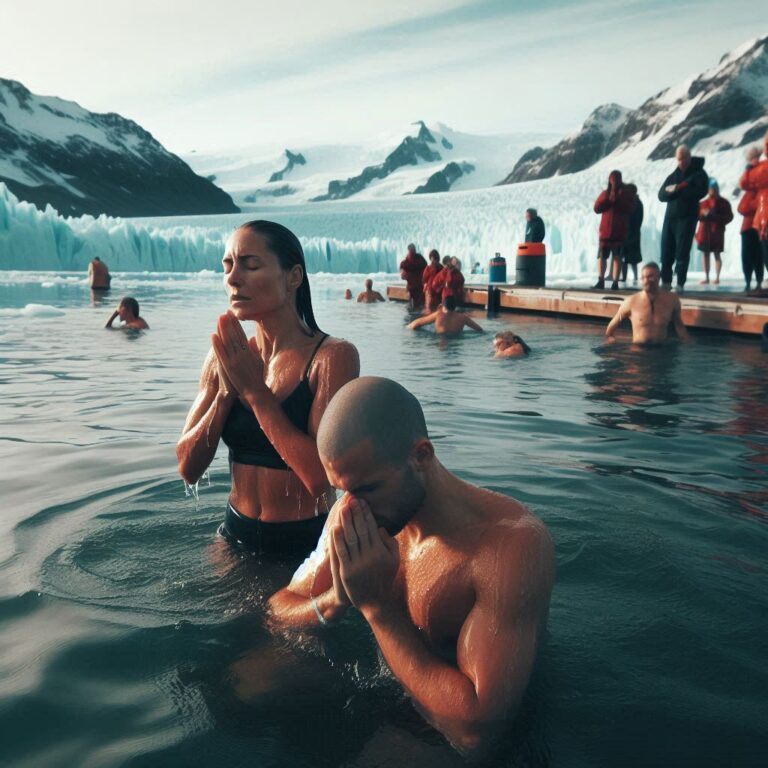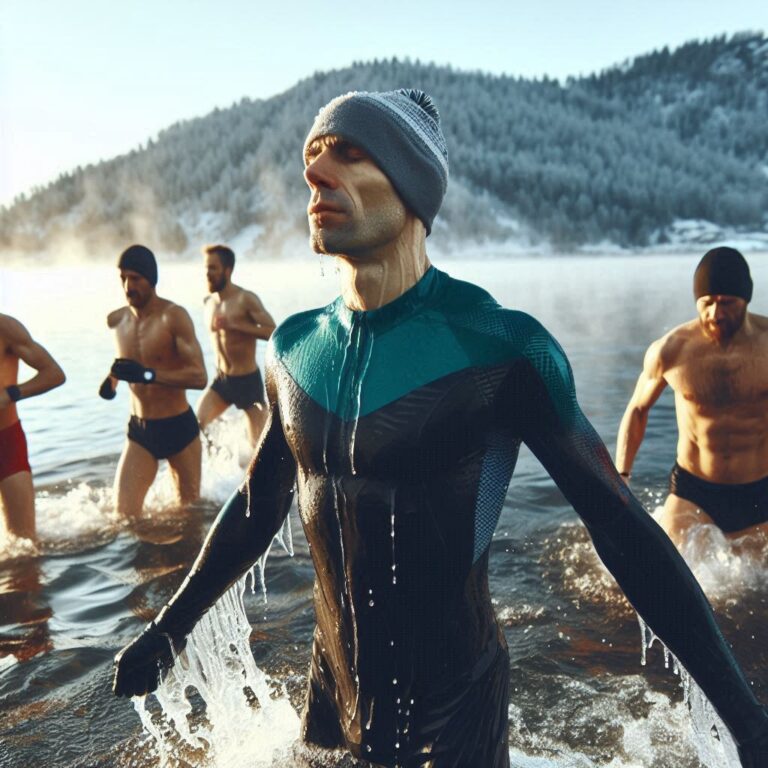Discover the benefits of ice baths and cold plunges for marathon training. Learn how these methods can boost recovery, enhance performance, and improve overall training results.
Marathon training is no joke. You know this. Your body knows this. And while it’s incredibly rewarding, it can take a serious toll on your physical and mental endurance. But fear not, my fellow marathoners! There is hope in the form of cold therapy. That’s right, ice baths and cold plunges can be your new best friend when it comes to recovery.
In this interactive guide, we’ll explore the many benefits of these chilly treatments, teach you the proper methods, and even share some interesting facts to keep you entertained along the way. So let’s dive in! But before that, let’s delve into it’s history.
Understanding Ice Baths and Cold Plunges
What Are Ice Baths and Cold Plunges?

Ice baths and cold plunges, oh how they can be both loved and hated by athletes alike! On one hand, they’re a brutal form of therapy that leaves you shivering, gasping for breath, and questioning your sanity.
On the other hand, they offer incredible benefits that can help you recover faster, reduce muscle soreness, and even boost your performance in the long run. So, are you ready to dive into the icy waters and unlock these hidden superpowers? Let’s find out!
Ice baths and cold plunges are particularly popular among athletes who participate in high-intensity workouts, endurance sports, or contact sports like football, basketball, or soccer.
The repetitive motions and impact associated with these activities can lead to muscle damage and inflammation, making ice baths and cold plunges a go-to method for recovery. However, even if you’re not an athlete, incorporating these cold therapies into your self-care routine can help with general muscle aches and pains.
History and Evolution
Cold therapy has been around for ages, and it’s no wonder why! From the Ancient Greeks and Romans dipping into frigid water to soothe their aches to modern athletes incorporating ice baths and cold plunges into their training regimens, this bad boy has proven itself time and time again.
So, what exactly is the deal with this chilly treatment, and why do so many people swear by it?
Benefits of Ice Baths and Cold Plunges
Reduction of Muscle Soreness
One of the most exciting perks of ice baths and cold plunges is their amazing power to vanquish post-workout muscle soreness. It’s like magic! When you submerge yourself in a chilly pool of water, your body’s blood vessels automatically tighten up, and your metabolism slows down. This ice-cold treatment works wonders in reducing inflammation and swelling, easing the discomfort we all know too well as “delayed onset muscle soreness” or DOMS.
As an athlete, you’ve probably experienced DOMS before – that achy, sore feeling that seems to creep up on you days after an intense workout. It’s not only uncomfortable, but it can also slow down your progress and keep you from performing at your best. That’s where ice baths and cold plunges come in! By using these simple, natural remedies, you can recover faster and get back to crushing your workout goals without any pain or discomfort.
Enhanced Recovery
Cold therapy is your new best friend when it comes to speeding up recovery time! By taking a plunge into the chilly waters, you’re actually supercharging your body’s natural healing process. The cold causes your blood vessels to constrict, forcing blood back to your core to protect your vital organs from the chill. But fear not, this isn’t all for show – it’s actually just a prelude to the awesomeness that’s about to unfold!
Decreased Inflammation
Once you’re done with your frigid dip, you’ll notice that your blood vessels begin to dilate, allowing a warm, oxygen-rich wave of blood to surge back out to your muscles. This rush of fresh blood delivers vital nutrients and oxygen to your hard-working muscles, while also flushing out any pesky metabolic waste products like lactic acid. This process is often referred to as vasodilation, and it’s the key to unlocking faster recovery times and reduced muscle fatigue.
But wait, there’s more! The increased blood flow also helps to clear out inflammation, which is the culprit behind sore muscles and achy joints. By giving your body this cold shock therapy, you’re essentially jump-starting the healing process and giving your muscles the kickstart they need to bounce back stronger and faster than ever before.
Improved Mental Resilience
Enduring the cold isn’t just about keeping your body warm, it’s also about training your mind to stay strong and focused. So, are you up for the challenge? Let’s dive in (pun intended!) to see how you can use cold therapy to build mental resilience and toughness that will not only help you power through those long training runs, but also make you feel unstoppable in any aspect of your life!
Here’s the deal: incorporating ice baths or cold plunges into your marathon training routine can help you develop a mindset that’s unfazed by discomfort. It’s all about learning to embrace the shiver and the shake, and using that inner strength to keep pushing forward. Think of it as mental conditioning for your brain, just like how you’re physically conditioning your body for those 26.2 miles.
So, how does it work? When you subject yourself to cold temperatures, your body goes into survival mode, releasing hormones like adrenaline and noradrenaline. This heightened state of alertness and focus can help you stay calm and collected even when things get tough during your runs. And believe us, there will be tough moments! But with the mental resilience and toughness you’ll develop from cold therapy, you’ll be able to push through those obstacles like a champion.
Boosted Immune Function
Cold therapy has been shown to stimulate the production of white blood cells, enhancing the body’s immune response. A robust immune system is crucial for athletes, as it helps protect against illness and supports overall health, ensuring consistent training without interruptions.
How to Incorporate Ice Baths and Cold Plunges into Your Training

Preparation
Before immersing yourself in that invigorating cold water, let’s make sure we’re both mentally and physically prepared for the plunge! First things first, don’t forget to hydrate well beforehand. You’ll need that extra boost of energy and warmth once you’re out of the water. Next, have a towel and some warm, cozy clothes nearby for when you’re feeling all nice and toasty again.
Now, let’s talk about mental preparation. Take a deep breath in and out, and focus on your breathing. Visualize yourself feeling refreshed and rejuvenated after the cold therapy. Imagine how amazing it’s going to feel when your body adapts to the temperature change, and your circulation improves. You’ve got this!
Duration and Frequency
The optimal time for an ice bath or cold plunge that’ll really get your blood pumping? You’re in luck! It’s typically between 10 to 15 minutes. But don’t worry if you’re just starting out – you can ease into it with shorter sessions of just 5 minutes. As you get more comfortable with the chill, feel free to slowly increase the time!
Now, the important question is, how often should you dive into these icy waters to reap the rewards? That all depends on your training intensity and personal preference. But as a general rule of thumb, 2-3 sessions per week should do the trick!
Temperature
Maintain the water temperature right in the middle of comfort and benefit! Keep it between 50 to 59 degrees Fahrenheit (10 to 15 degrees Celsius). Use a thermometer to keep track and make sure you’re not going too cold, which can lead to hypothermia, or too warm, as it may not give you the results you’re after. So, let’s get testing and perfect that water temperature together!
Post-Plunge Care
After an icy plunge or cold therapy session, it’s important to warm up gently and gradually. Begin by stepping out of the chilly water and patting yourself dry. Once you’re toasty, slip into some warm clothes to keep your body temperature in check.
For an extra boost, try gentle stretching or light movement to get your blood flowing again. This will help your muscles warm up and prepare for any upcoming activities. Avoid hot showers right away, as they can actually counteract the benefits of the cold therapy. Instead, opt for a lukewarm shower or bath to continue the warming process.
Interesting Facts About Ice Baths and Cold Plunges
Fact 1: Endurance Athletes Swear By It
Many elite endurance athletes, such as marathon runners, triathletes, and cyclists, are known to incorporate ice baths and cold plunges into their recovery routines. They swear by the incredible benefits of cold therapy, crediting it with helping them recover faster and perform at their best.
Fact 2: The Science Behind Vasoconstriction and Vasodilation
Ice baths, also known as cryotherapy, have a surprising effect on your blood vessels. After taking a dip in those chilly waters, your blood vessels start to constrict, or get narrower. This process is called vasoconstriction and it helps to reduce blood flow to your muscles.
But don’t worry, it’s not forever! Once you get out of the ice bath, your blood vessels start to dilate, or widen back up. This process is called vasodilation and it increases blood flow back to your muscles.
Fact 3: Cold Therapy and Mood Enhancement
Exposure to cold water isn’t just refreshing, it’s actually good for your mental health! When you take a plunge, your body reacts by releasing those feel-good chemicals called endorphins, which act as natural painkillers and mood boosters. This endorphin rush can do wonders for your mood and help reduce stress levels, leaving you feeling happier and more relaxed.
Fact 4: Not Just for Athletes
While athletes are the primary users of ice baths and cold plunges, these chilling techniques can actually benefit anyone looking to achieve a variety of health and wellness goals. Not only can they help reduce muscle soreness and speed up recovery time, but they can also boost mental resilience and overall well-being. And guess what? These trendy techniques aren’t just for the pros! They’re becoming increasingly popular among fitness enthusiasts and everyday folk alike who are seeking out holistic approaches to self-care.
Fact 5: Wim Hof Method
The Wim Hof Method, founded by the incredible Dutch extreme athlete Wim Hof, revolves around embracing the cold as a powerful tool for enhancing both physical and mental well-being. This unique approach blends controlled breathing techniques, intentional exposure to cold temperatures, and mindful meditation to create a transformative experience that has captivated people from all corners of the globe.
As you dive deeper into the Wim Hof Method, you’ll discover that cold therapy plays a pivotal role in unlocking your body’s true potential. It’s like hitting the reset button for your nervous system.
Practical Tips for Effective Cold Therapy
Controlled Breathing: Master the Art of Staying Calm
When you first step into that ice-cold shower or take the plunge into the chilly pool, controlled breathing can be a lifesaver. Inhale deeply and slowly, filling your lungs with air, and then exhale just as slowly. This technique helps calm your nervous system, making the initial shock more bearable. Try it now: close your eyes, take a deep breath in, and then release it slowly as you exhale. With each breath, visualize yourself becoming more and more accustomed to the cold.
Gradual Acclimation: Ease into the Cold
If you’re new to cold therapy, don’t dive right in! Start with lukewarm or cool showers and gradually decrease the temperature over time. This gradual acclimation allows your body to adjust to the cold more comfortably and effectively. Take a step back and think about it: have you ever jumped into a pool that was too cold? It probably didn’t feel great. Now imagine easing into it slowly, getting used to the temperature change each step of the way. That’s what gradual acclimation is all about.
Commit to Consistency: Unlock Your Body’s Potential
The key to unlocking the full potential of cold therapy lies in consistency. Just like with exercise or any other form of self-improvement, regular practice is essential for seeing results. Try setting a schedule for your cold therapy sessions and sticking to it. Soon enough, you’ll find that your body adapts to the cold more easily, and you’ll be reaping the rewards of improved recovery and performance.
Listen to Your Body: Pay Attention to the Signs
While cold therapy can be incredibly beneficial, it’s important to listen to your body and be aware of any potential warning signs. Prolonged numbness, pain, or discomfort could indicate an issue that needs medical attention. As you experiment with different temperatures and durations, keep track of how your body feels. This way, you can adjust your routine as needed and avoid any unnecessary discomfort or injury.
In conclusion, Ice baths and cold plunges are powerful tools for marathon runners seeking to enhance their recovery and performance. By reducing muscle soreness, decreasing inflammation, and improving mental resilience, cold therapy can play a significant role in your training regimen. Incorporate these methods safely and consistently to maximize their benefits and support your marathon training journey. Remember to listen to your body and consult with professionals if needed to ensure a balanced and effective approach to recovery.
So what are you waiting for? Dive in, embrace the cold, and experience the invigorating benefits of cold therapy for yourself! Your body will thank you for it.
FAQs
What is the ideal duration for an ice bath or cold plunge?
The ideal duration for an ice bath or cold plunge is typically between 10 to 15 minutes. Beginners can start with shorter sessions of 5 minutes and gradually increase the time as they become more accustomed to the cold.
How often should I take ice baths or cold plunges?
The frequency of ice baths or cold plunges depends on the intensity of your training and personal preferences. Generally, 2-3 sessions per week are sufficient to reap the benefits without overexposing your body to cold therapy.
What temperature should the water be for effective cold therapy?
The water temperature for effective cold therapy should be between 50 to 59 degrees Fahrenheit (10 to 15 degrees Celsius). Use a thermometer to ensure the water is within this range.
Can ice baths and cold plunges help with mental resilience?
Yes, regularly subjecting yourself to cold therapy can build mental resilience and toughness. The ability to remain calm and focused in uncomfortable situations can improve mental fortitude during marathon training and races.
Are there any risks associated with ice baths and cold plunges?
While generally safe, ice baths and cold plunges can pose risks such as hypothermia if the water is too cold or if the immersion time is too long. Always monitor the temperature, duration, and your body’s response to cold therapy.
Can cold therapy boost immune function?
Yes, cold therapy has been shown to stimulate the production of white blood cells, enhancing the body’s immune response. A robust immune system is crucial for athletes, helping protect against illness and supporting overall health.


